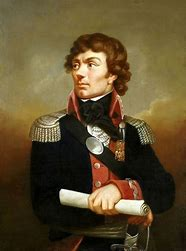 THADDEUS KOSCIUSZKO (1746-1817) – As my last name makes clear, I’m of Polish American descent. Last 4th of July I made a blog post about the Polish General Casimir Pulaski‘s career during the Revolutionary War. This year I’m taking a look at another Polish officer who served in the American armed forces during that conflict.
THADDEUS KOSCIUSZKO (1746-1817) – As my last name makes clear, I’m of Polish American descent. Last 4th of July I made a blog post about the Polish General Casimir Pulaski‘s career during the Revolutionary War. This year I’m taking a look at another Polish officer who served in the American armed forces during that conflict.
Just as Pulaski is remembered as “the father of American cavalry,” Kosciuszko is often referred to as the father of America’s Army Corps of Engineers. Thaddeus’ brilliant improvisational engineering and architectural works proved essential to winning American independence.
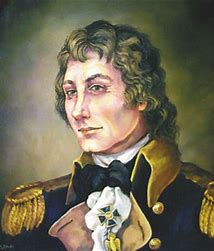 After receiving his education and military training in Europe, Kosciuszko sailed for America in June 1776. Unlike his fellow Pole Casimir Pulaski, he had missed out on serving in the Bar Uprising in Poland and was enthusiastic about fighting in the Revolutionary War. Poland’s long history of religious tolerance made Thaddeus feel a certain kinship with those who held similar sentiments in our emerging nation.
After receiving his education and military training in Europe, Kosciuszko sailed for America in June 1776. Unlike his fellow Pole Casimir Pulaski, he had missed out on serving in the Bar Uprising in Poland and was enthusiastic about fighting in the Revolutionary War. Poland’s long history of religious tolerance made Thaddeus feel a certain kinship with those who held similar sentiments in our emerging nation.
By August 30th of 1776 Kosciuszko was in Philadelphia presenting his request for service to the Second Continental Congress. The next day he was accepted and assigned to America’s Continental Army. Thaddeus’ first undertaking was the construction of fortifications at Fort Billingsport in Paulsboro, NJ to prevent a British advance up the Delaware River.
Kosciuszko impressed his superiors with his ingenuity and ability to get the job done with the limited resources the struggling United States possessed at the time. On October 18th, 1776 the Continental Congress made him a Colonel of Engineers.
In the spring of 1777, Thaddeus was reassigned to the Northern Army under General Horatio Gates. In May, Colonel Kosciuszko completed his surveys at Fort Ticonderoga and recommended the establishment of artillery on Sugar Loaf, an elevated area overlooking the fort.
General Arthur Saint Clair turned down the recommendation, which proved disastrous for the Continental Army. In July 1777 British General “Gentleman Johnny” Burgoyne launched his siege of Fort Ticonderoga, establishing an artillery battery on Sugar Loaf and thus inflicting a crushing defeat on the American forces.
As the frantic Continental troops retreated south toward the Hudson River with the Redcoats breathing down their necks, American General Philip Schuyler ordered Colonel Kosciuszko to do everything possible to delay the enemy.
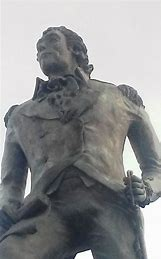 Thaddeus and his men felled trees across roadways, dammed streams and destroyed bridges and causeways. These actions slowed the British advance to a crawl and permitted the American troops to reach the Hudson and cross over to its southern bank.
Thaddeus and his men felled trees across roadways, dammed streams and destroyed bridges and causeways. These actions slowed the British advance to a crawl and permitted the American troops to reach the Hudson and cross over to its southern bank.
General Gates then assigned Kosciuszko to find the most defensible position in the area and erect fortifications there. Thaddeus did some recon and chose Saratoga as the best location for the Continental Army to withstand Burgoyne’s impending attack.
Thaddeus’ array of defenses proved virtually impregnable, making an enormous contribution to the American victory in the Saratoga Campaign. General Gates accepted Burgoyne’s surrender on October 16th.
Horatio Gates praised Kosciuszko extensively, stating that “The great tacticians of the campaign were hills and forests, which a young Polish engineer was skillful enough to select for my encampment.”
Thaddeus was assigned a new orderly – an 18-year-old freeborn African American from Massachusetts named Agrippa Hull, a rising historical figure himself. Kosciuszko and Hull famously related to each other as friends, and this camaraderie contributed to the Polish officer becoming a very early Abolitionist.
In March of 1778, Thaddeus and his staff arrived at his new assignment: the fortress at West Point, NY, which was crucial to American forces. With the vision and drive of an artist, Kosciuszko spent the next two years refining and further refining the West Point defenses, making them an innovative marvel for the time period.
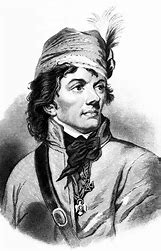 August 1780 saw General George Washington honor Thaddeus’ request for a combat command with the Southern Army. The Pole relocated to North Carolina, where he was reunited with his former superior General Horatio Gates, who was soon removed from command following several setbacks, including his loss at Camden.
August 1780 saw General George Washington honor Thaddeus’ request for a combat command with the Southern Army. The Pole relocated to North Carolina, where he was reunited with his former superior General Horatio Gates, who was soon removed from command following several setbacks, including his loss at Camden.
On December 3rd, Washington’s new choice to lead the Southern Army, General Nathanael Greene, took command and respected Kosciuszko’s accomplishments enough to retain him as his Chief Engineer during his overhaul of the staff.
Greene had Thaddeus and his men construct bateaux boats in addition to defensive works and temporary bridges. When the Southern Army was forced to retreat northward in January and February of 1781 (the famed “Race to the Dan River”), Kosciuszko’s improvised engineering marvels under fire proved crucial to keeping the army intact.
Furthermore, the pursuing British General Charles Cornwallis was stopped cold by the Halifax, VA fortifications that Gates had had Thaddeus construct on his way to North Carolina the previous year. This enabled the Southern Army to regroup and then launch Greene’s campaign to take back both Carolinas and have his subordinate General “Mad Anthony” Wayne wrest Georgia from British control.
After participating in battles during March and April 1781, Kosciuszko received a bayonet wound from a Redcoat during the May 22nd to June 18th siege of the star fort called Ninety-Six in South Carolina. After that, the Polish officer oversaw improvements to the various American positions in the Carolinas.
Thaddeus commanded assorted offensive harrying operations against British forces near Charleston and, after his friend Colonel John Laurens was slain during the Battle of Combahee River on August 27th, 1782, Kosciuszko was given command over his late friend’s military intelligence network in the Carolinas.
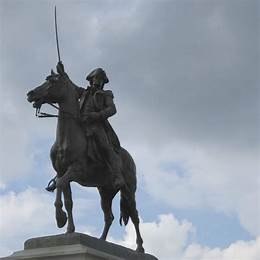 Thaddeus was simultaneously in charge of two cavalry squadrons and an infantry unit. His final combat experience came at James Island, SC on November 14th, 1782. Ironically, it was a British victory.
Thaddeus was simultaneously in charge of two cavalry squadrons and an infantry unit. His final combat experience came at James Island, SC on November 14th, 1782. Ironically, it was a British victory.
Colonel Kosciuszko was among the American forces who triumphantly entered Charleston after the British evacuation in December. When word of the April 23rd, 1783 Treaty of Paris, which finalized the British defeat, reached Charleston, Thaddeus was charged with organizing a spectacular fireworks display as part of the celebration ceremonies.
At the request of Congress, the Colonel oversaw the fireworks at Princeton’s 4th of July festivities that year, the first Independence Day to be marked after the official end of the war. In October 1783, Kosciuszko was promoted to brigadier general in the Continental Army.
On July 15th, 1784, General Kosciuszko returned to Poland, where he worked politically and militarily for years in the cause of Polish sovereignty and national identity. Thaddeus even served as a General in the Polish-Russian War of 1792, in which he never lost a battle.
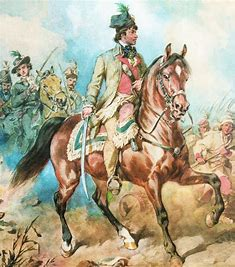 Kosciuszko adventured around Europe, always just a few steps ahead of Russian Tsarina Catherine the Great’s intelligence agents. Over time, Thaddeus cobbled together the Kosciuszko Uprising in which Poland and Lithuania fought Russia and Prussia from March 24th – November 16th, 1794.
Kosciuszko adventured around Europe, always just a few steps ahead of Russian Tsarina Catherine the Great’s intelligence agents. Over time, Thaddeus cobbled together the Kosciuszko Uprising in which Poland and Lithuania fought Russia and Prussia from March 24th – November 16th, 1794.
Unfortunately, Russia and Prussia won the conflict and inflicted the Third Partition of Poland on the losing side. Poland and Lithuania were written off the maps, their territory divided up between the two victors.
For a few years, Thaddeus returned to the United States, but went back to Europe in 1798. A wanted man by the Russians and Prussians, Kosciuszko eventually settled in Solothurn, Switzerland, where he died of a stroke on October 15th, 1817.
Here in the U.S. Thaddeus Kosciuszko was a huge name for Polish Americans. Many of us remember participating in parties and weddings being held at various Kosciuszko Clubs around the country.
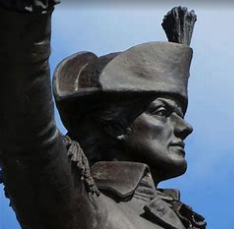 During 1777, this extraordinary man composed a Chodzony (Polonaise) for the harpsichord. Provided with lyrics, it became a popular song among Polish rebels during the Polish-Russian War of 1830-1831.
During 1777, this extraordinary man composed a Chodzony (Polonaise) for the harpsichord. Provided with lyrics, it became a popular song among Polish rebels during the Polish-Russian War of 1830-1831.
One closing note about Thaddeus Kosciuszko – throughout his Revolutionary War service he wore a Spanish sword on which was inscribed the words “Do not draw me without reason; do not sheathe me without honour.“

A very informative post, Ed. As it turns out, our highest mountain in Australia is named after the same person 😊
Thank you, and wow, I did not know that! Thanks for the information!
Fox Business is broadcasting Legends and Lies American Revolution series, usually behind the pay window on Fox Nation. It’s well done!
Thanks for the heads up, and Happy Fourth!
Thank you, sir!
My pleasure!
😀
They all had a great effect on the American army! Well shared!
Thank you!
🙏
😀
🏖️🏖️🏖️
Such a character!
🤩🤩🤩🤩
😀 😀 😀 😀 😀
😘😘😘😘😘
You’re so inventive!
Ha ha ha 🤔🤔🤔
😀
🙄🙄🙄🙄
Thanks!
😁
A very informative post.
Thank you!
Nice informative post on this Polish military hero. It’s funny I never seemed to recognize him much when I taught American History? My mistake it seems.
Thanks! If I hadn’t grown up in communities where he and Casimir Pulaski were big names I might have overlooked them, too.
Funny I came across his name in a recent episode of Outlander I watched.
That’s a fun coincidence!
I’m a big believer in the power of coincidence? And you?
Depends on my mood, but one of my doctors once had a saying that “Coincidence is God autographing his work.” I’m not religious but I like that saying.
Good posts as always. I had never heard about this revolutionary war hero before, so I found this post to be educational. While I have limited knowledge regarding the revolutionary war, I do appreciate war films. For instance, your post about revolutionary war heroes brought to mind the fantastic war film “All Quiet on the Western Front”. A unique war movie that took the point-of-view of German soldiers. Definitely worth watching.
Here’s why I loved it:
“All Quiet on the Western Front” (2022) – Movie Review – The Film Buff (huilahimovie.reviews)
Thank you! Your review of All Quiet on the Western Front is great!